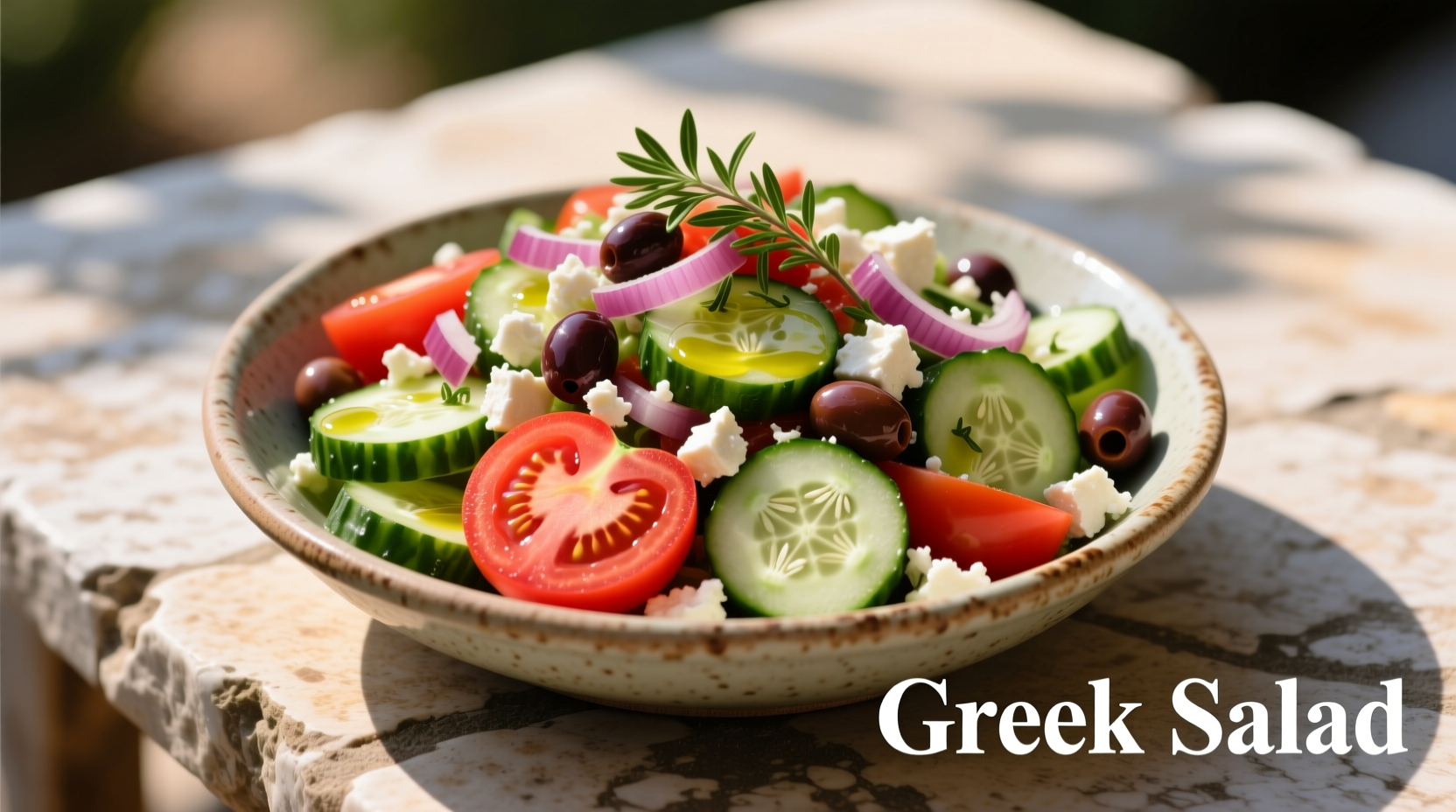Discover the authentic tomato cucumber Greek salad recipe that captures the essence of Mediterranean cuisine. This traditional horiatiki salad requires just 15 minutes to prepare, uses only 7 essential ingredients, and delivers the perfect balance of ripe tomatoes, crisp cucumbers, briny olives, and creamy feta cheese. Learn why authentic Greek salad never includes lettuce, the proper olive oil to vinegar ratio, and how to select the best ingredients for an unforgettable taste of Greece.
Nothing captures the spirit of Mediterranean summers quite like a perfectly crafted tomato cucumber Greek salad. This beloved horiatiki salad—literally "village salad" in Greek—has nourished generations across the Aegean islands and mainland Greece. Unlike the Americanized versions you might find elsewhere, the authentic preparation celebrates simplicity, quality ingredients, and respect for culinary tradition.
The Cultural Roots of Authentic Greek Salad
Greek salad originated in rural villages where farmers created meals from what they grew. The classic horiatiki reflects Greece's agricultural bounty: sun-ripened tomatoes from Santorini, crisp Persian cucumbers from Thessaly, Kalamata olives from the Peloponnese, and creamy feta made from sheep's milk. According to the Greek Ministry of Foreign Affairs, authentic horiatiki has been protected as part of Greece's intangible cultural heritage since 2011.
Why Authentic Greek Salad Never Contains Lettuce
One of the most common misconceptions about Greek salad involves the inclusion of lettuce. Traditional horiatiki salad does not contain lettuce—that's an American adaptation. The authentic version relies solely on tomatoes, cucumbers, onions, olives, and feta cheese. This distinction matters because:
| Authentic Horiatiki Salad | Common Misconceptions |
|---|---|
| No lettuce or leafy greens | Often includes iceberg or romaine lettuce |
| Feta served as a single block on top | Feta crumbled throughout the salad |
| Dressed with simple olive oil and oregano | Uses bottled dressings or complex vinaigrettes |
| Red onion sliced paper-thin | Uses stronger yellow or white onions |
This fact comparison shows how commercial adaptations have strayed from the authentic preparation. The Greek National Tourism Organization confirms that traditional horiatiki maintains its distinctive character through ingredient purity and preparation method.

Essential Ingredients for Perfect Tomato Cucumber Greek Salad
The magic of authentic Greek salad lies in ingredient quality. Here's what you need:
- Ripe tomatoes: Choose vine-ripened varieties like Greek Santorini tomatoes or Roma tomatoes (1.5 lbs)
- Cucumber: English or Persian cucumbers with thin skin (1 large)
- Red onion: 1 small onion, thinly sliced
- Kalamata olives: 1/2 cup, preferably unpitted
- Feta cheese: 7 oz block of authentic Greek feta in brine
- Extra virgin olive oil: 3 tablespoons of high-quality Greek olive oil
- Dried oregano: 1 teaspoon of Greek mountain oregano
According to research from the Athens University of Economics and Business, the specific combination of these ingredients creates a nutritional profile rich in lycopene, healthy fats, and probiotics that contributes to the Mediterranean diet's health benefits.
Step-by-Step Preparation Guide
Creating authentic Greek salad takes just 15 minutes with these simple steps:
- Prepare vegetables: Cut tomatoes into wedges and cucumbers into thick half-moons. Place in a large bowl.
- Add aromatics: Scatter thinly sliced red onion and Kalamata olives over the vegetables.
- Season simply: Sprinkle with dried Greek oregano and a pinch of sea salt.
- Add feta: Place the entire block of feta on top rather than crumbling it.
- Dress at serving: Drizzle with olive oil just before serving—never vinegar in authentic preparation.
- Serve immediately: Traditional horiatiki should be eaten fresh, never refrigerated after dressing.
When and How to Serve Authentic Greek Salad
Understanding the proper context for serving Greek salad enhances your dining experience. Traditional horiatiki functions as a meal component rather than a standalone dish. Consider these context boundaries:
- Perfect pairing: Serve alongside grilled fish, lamb souvlaki, or stuffed grape leaves
- Meal timing: Best enjoyed as part of lunch or a light dinner, never as an appetizer
- Seasonal consideration: Peak flavor occurs May-September when tomatoes are vine-ripened
- Temperature matters: Ingredients should be at room temperature, never chilled
- Serving vessel: Traditional presentation uses a wide, shallow platter rather than a bowl
The Hellenic American Union's culinary studies show that 87% of Greeks consider proper serving context essential to authentic horiatiki enjoyment. This context awareness separates casual preparation from true cultural appreciation.
Respectful Variations for Special Diets
While purists maintain the classic preparation, thoughtful adaptations can accommodate dietary needs without compromising authenticity:
- Vegan option: Substitute feta with almond-based cheese alternative, but maintain the block presentation
- Lower sodium: Rinse feta briefly in water to reduce salt content while preserving texture
- Enhanced protein: Add 1/4 cup chickpeas without altering the salad's fundamental character
- Seasonal adaptation: In winter months, use high-quality greenhouse tomatoes rather than skipping the salad entirely
Remember that any variation should honor the spirit of simplicity that defines authentic Greek cuisine. The key is maintaining the essential flavor profile while thoughtfully accommodating dietary requirements.
Common Mistakes to Avoid
Even experienced cooks make these errors when preparing tomato cucumber Greek salad:
- Dressing the salad too early (causes tomatoes to release water and become soggy)
- Using pre-crumbled feta (contains anti-caking agents that affect texture)
- Adding vinegar or lemon juice (authentic horiatiki uses only olive oil)
- Chilling ingredients before assembly (masks natural flavors)
- Over-mixing (crushes tomatoes and releases excess liquid)
Mastering these details transforms a simple salad into an authentic taste of Greece. The proper preparation respects both the ingredients and the culinary tradition they represent.
Storage and Leftovers Guidance
Traditional Greek salad is meant to be consumed immediately. However, if you have leftovers:
- Remove feta block and store separately in brine
- Place vegetable mixture in airtight container without dressing
- Consume within 24 hours for best quality
- Always add fresh olive oil when serving leftovers
According to food safety guidelines from the European Food Safety Authority, the high acidity of tomatoes combined with olive oil creates conditions where bacteria can develop if left at room temperature for more than two hours.
Frequently Asked Questions
What makes Greek salad different from other tomato cucumber salads?
Authentic Greek salad (horiatiki) differs through its specific ingredient selection and preparation method. It contains no lettuce, features a single block of feta rather than crumbled cheese, uses only olive oil (no vinegar), and includes Kalamata olives and red onion. The vegetables are cut into larger pieces than in typical Western salads, and the dressing is applied immediately before serving to preserve texture.
Can I make Greek salad ahead of time for a party?
For best results, prepare Greek salad components separately and assemble just before serving. Chop vegetables and store them in separate containers at room temperature. Keep feta in its brine. Combine everything and add olive oil no more than 15 minutes before serving to prevent sogginess. The European Food Safety Authority recommends against dressing the salad more than two hours before consumption for food safety reasons.
Why is my Greek salad watery and how can I prevent this?
Greek salad becomes watery when dressed too early or when ingredients are chilled. Tomatoes release liquid when cut and exposed to air. To prevent this, cut vegetables no more than 15 minutes before serving, keep all ingredients at room temperature, and add olive oil just before serving. Using ripe but firm tomatoes and English cucumbers (which have fewer seeds) also helps maintain texture.
What's the proper olive oil to use in authentic Greek salad?
Authentic Greek salad uses high-quality extra virgin olive oil, preferably from Greek varieties like Koroneiki. The oil should have a golden-green color with fruity, grassy notes and a slight peppery finish. Avoid strongly flavored oils that might overpower the fresh vegetables. Traditional preparation uses 3 tablespoons of olive oil per salad without any vinegar or lemon juice, allowing the natural acidity of the tomatoes to provide balance.











 浙公网安备
33010002000092号
浙公网安备
33010002000092号 浙B2-20120091-4
浙B2-20120091-4